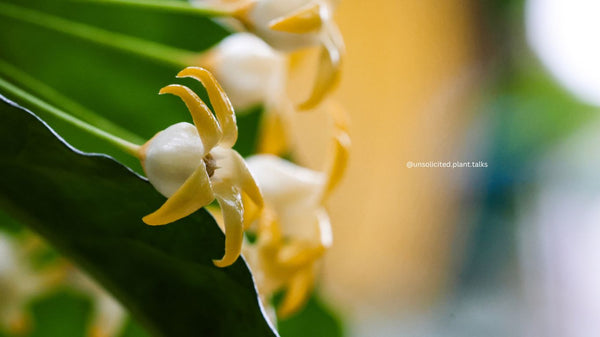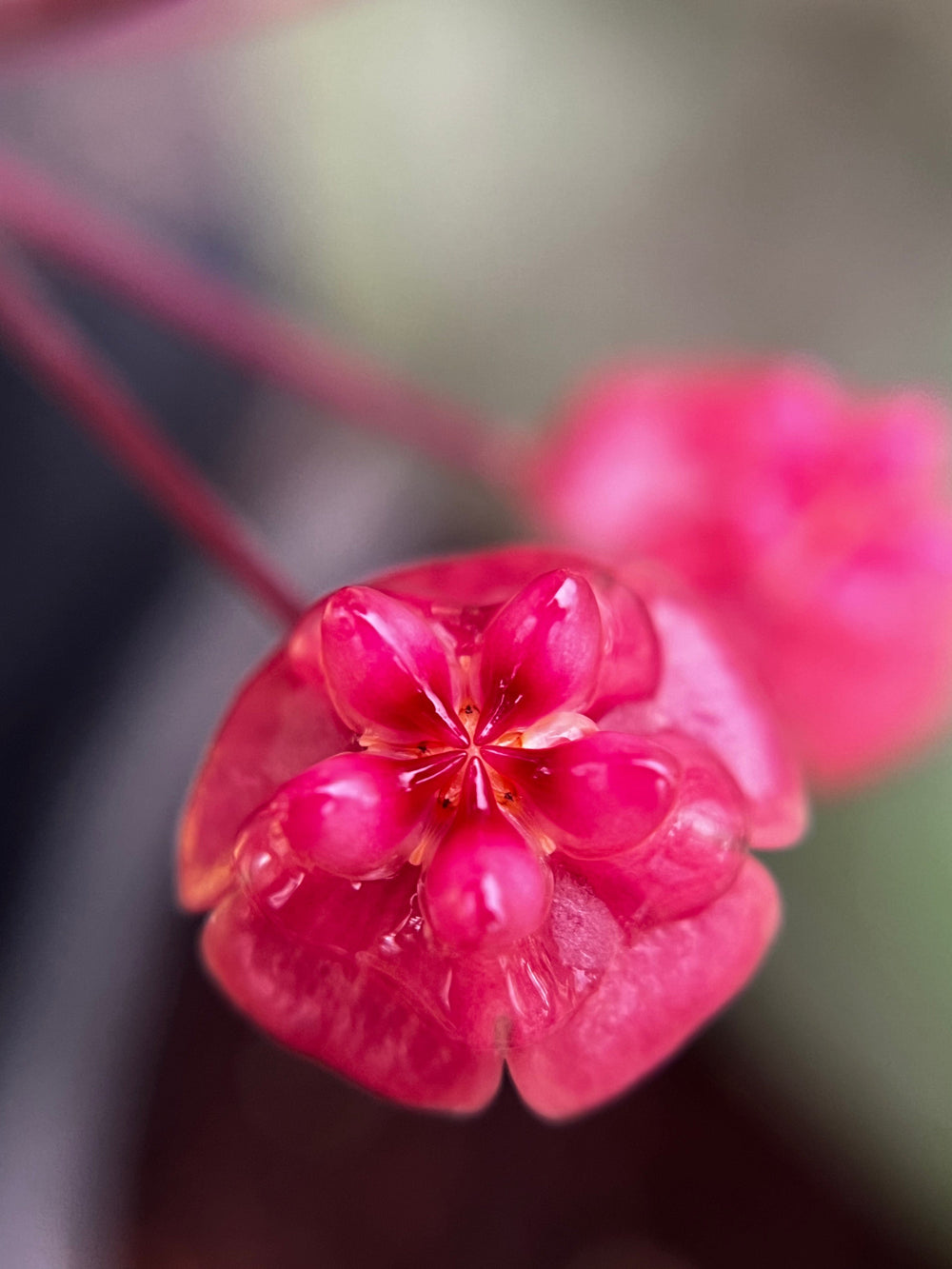Rare House Plants

Table of Contents
- Hoyas
- Dischidias
- Aroids
- Jewel Orchid
- Alocasia Polly
- String of Hearts
- How to Care for Rare House Plants?
- The Bottom Line
Hoyas
Hoyas, commonly known as wax plants, are a group of tropical and subtropical plants that belong to the Apocynaceae family. Renowned for their waxy, succulent leaves and unique pendulous growth habits, Hoyas have gained a dedicated following among plant collectors.
One of the most sought-after varieties is the Hoya polyneura, commonly known as the fishtail hoya. The elongated, lance-shaped leaves feature prominent veins that run parallel to the edges, creating an eye-catching display reminiscent of a fishtail. Hoya polyneura is an epiphytic species, meaning it naturally grows on other plants without being parasitic. When cultivated, it thrives in well-draining soil and prefers bright, indirect light. This hoya is known for producing clusters of small, star-shaped flowers with a subtle fragrance.
Another intriguing Hoya species is the Hoya latifolia which stands out for its large, broad leaves that can reach impressive sizes. The glossy, elliptical leaves are typically dark green and can develop attractive reddish hues under certain growing conditions. This hoya is a climbing or trailing plant, making it well-suited for hanging baskets or allowing it to cascade gracefully from elevated positions, such as moss poles.
Dischidias

Dischidias, close relatives of Hoyas, are succulent vines that belong to the Apocynaceae family. These rare house plants are appreciated for their fleshy leaves and peculiar growth patterns. Among the captivating Dischidia species is the Dischidia ovata, commonly referred to as Watermelon Dischidia.
The leaves of Dischidia ovata are small, round, and green, often with lighter green or silver spots that give them a watermelon-like appearance. As with many Dischidia plants, D. ovata is epiphytic, meaning it can grow on other surfaces such as trees. In cultivation, it is typically grown in well-draining soil or a suitable epiphytic mix.
Another noteworthy member of the Dischidia family is the Dischidia major, also known as the Ant Plant. This unique species forms a symbiotic relationship with ants, which use the hollow, swollen structures on the leaves as nesting sites. In return, the ants provide protection to the plant. The Ant Plant prefers bright, filtered light and requires a humid environment for optimal growth.
Aroids

Aroids, belonging to the Araceae family, encompass a diverse group of plants known for their stunning foliage and unique inflorescences. While some aroids are common houseplants, several rare and exotic varieties have gained popularity among enthusiasts for their intricate leaf patterns and striking visual appeal.
The Alocasia ‘Dragon Scale’, a rare Alocasia species, is distinguished by its robust, dragon-like textured leaves. The metallic appearance of the foliage adds a touch of opulence to any indoor space. Alocasia dragon scale thrives in bright, indirect light and requires consistent humidity levels to maintain its health.
Philodendron ‘Pink Princess’, a captivating member of the Philodendron genus, is renowned for its deep green and vibrant pink variegation. This rare house plant requires well-draining soil and moderate light, making it a favorite among collectors seeking a visually stunning centerpiece.
Jewel Orchid
The Jewel Orchid, with its scientific name Ludisia discolor, is a true gem in the world of rare house plants. Native to Southeast Asia, this orchid variety is distinguished by its velvety, deep green leaves adorned with intricate patterns resembling precious gemstones.
While the Jewel Orchid's blooms are relatively modest, appearing as small clusters of delicate flowers, its primary allure lies in the lush and captivating foliage. Perfect for shaded corners, this orchid not only adds a touch of opulence to your indoor space but also thrives in well-draining soil with a consistent moisture level.
Alocasia Polly
Often referred to as the African Mask Plant, the Alocasia polly is a captivating member of the Alocasia family. Its arrow-shaped leaves boast striking dark green, almost black, hues with contrasting white veins, creating an appearance reminiscent of tribal masks.
The Alocasia polly's unique aesthetic makes it a focal point in any indoor garden. To ensure its thriving growth, provide it with bright, indirect light, and maintain a well-draining soil mix. Be mindful of its watering needs, allowing the top inch of soil to dry out between waterings.
String of Hearts
Delicate and graceful, the String of Hearts, scientifically known as Ceropegia woodii, is a trailing succulent that enchants with its cascading vines adorned with small, heart-shaped leaves. Native to South Africa, this plant not only adds a touch of romance to your indoor space but is also relatively easy to care for, making it suitable for plant enthusiasts of all levels.
To ensure optimal growth, provide the String of Hearts with bright, indirect light, and let the soil dry out between watering sessions. Its cascading vines make it an ideal candidate for hanging baskets or as a trailing feature in your plant arrangements.
How to Care for Rare House Plants?
Cultivating rare house plants requires a blend of passion, patience, and horticultural knowledge. Here are some general tips for successfully growing and maintaining these enchanting species in your indoor oasis:
- Light: Provide bright, indirect light for most species, avoiding prolonged exposure to direct sunlight. Adjust lighting conditions based on the specific requirements of each plant.
- Soil: Use a well-draining potting mix to prevent waterlogged soil, which can lead to root rot. Consider adding perlite or orchid bark to enhance drainage.
- Watering: Allow the top inch of soil to dry out before watering, as overwatering is a common issue with many rare house plants. Make sure to adjust the watering frequency based on environmental factors such as humidity and temperature.
- Humidity: Maintain adequate humidity levels, especially for plants like Dischidia pectinoides and Alocasia dragon scale. Also, consider grouping plants together or using a humidifier, as it can help create a suitable microclimate.
- Temperature: Keep indoor temperatures within the preferred range for each species, avoiding sudden temperature fluctuations.
- Fertilization: Feed plants during the growing season with a balanced liquid fertilizer diluted to half strength. Remember to reduce or eliminate fertilization during the dormant winter months.
The Bottom Line
Rare house plants offer a glimpse into the diverse and enchanting world of botanical wonders. Cultivating these unique species not only adds a touch of sophistication to your indoor space but also provides a rewarding experience for plant enthusiasts. As you embark on the journey of caring for these extraordinary plants, remember to tailor your care routine to the specific needs of each genus and species, allowing them to thrive and flourish in your botanical haven.
Would you like to know more about rare house plants? Feel free to get in touch with us at support@unsolicitedplanttalks.com - we’ll be thrilled to answer any questions you may have and introduce you to the fascinating world of exotic plants.











